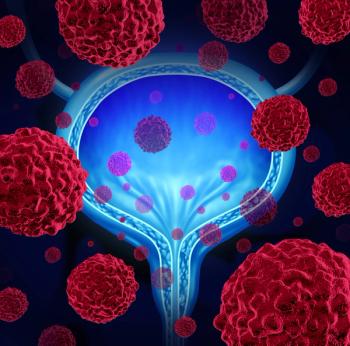
Chemo Plus Radiation Beats Surgery in Muscle Invasive Bladder Cancer
Adding chemotherapy to radiation therapy for muscle invasive bladder cancer may allow up to 67% of patients to be free of disease two years post-treatment, according to a study out of the UK. In addition, this treatment combination may offer a significant number of patients a better quality of life by avoiding surgery.
Adding chemotherapy to radiation therapy for muscle invasive bladder cancer may allow up to 67% of patients to be free of disease two years post-treatment, according to a study out of the UK. In addition, this treatment combination may offer a significant number of patients a better quality of life by avoiding surgery.
"The trial shows that this treatment offers improved control of cancer within the bladder with acceptable long-term side effects and is, therefore, a viable alternative to radical surgery in patients with muscle invasive bladder cancer," said study investigator Nicholas James, MD, who is an oncologist at the University of Birmingham. "This may shift the balance from surgery to chemoradiotherapy as the primary treatment for many patients with invasive bladder cancer."
In the U.S., the most common treatment for advanced bladder cancer is cystectomy, which compromises patients’ normal urinary function. Radiotherapy has been used as an alternative for some time. However, in recent years, researchers have been making advances in combining radiation therapy and chemotherapy as a way to treat bladder cancer while allowing patients an opportunity to maintain normal bladder function.
"There is a big difference in the path of care between the U.S. and the UK in this regard," Dr. James said in an interview with Oncology News International. "In the U.S. only about 10% of patients get offered radiotherapy, and it is viewed very much as a niche treatment. There is a misconception that radiotherapy gives you a small, shrunken, poorly functioning, bladder."
In contrast, 60% of eligible UK patients get radiotherapy, Dr. James said. In the current study, 75% of the patients reported no late (three months post-treatment) side effects. Of the 25% who reported side effects, fewer than 5% reported them as serious. "We had the surgeons measure bladder volumes, and the average loss of bladder volume was 10%," he explained.
The multicenter randomized trial, conducted at 45 institutions in the UK, examined whether adding chemotherapy to radiation treatment was safe and more effective than giving radiation alone in preventing bladder cancer recurrence. The trial compared two ways of giving radiation. The patients were randomized in a 2 × 2 factorial design to chemoradiotherapy (CRT) vs radiotherapy alone (RT) and/or to standard RT (to tumor and whole bladder with 1.5 cm margin) vs reduced high-dose-volume RT (tumor plus 1.5 cm margin treated to 100% target dose and remaining bladder to 80% target dose).
From August 2001 to April 2008, 458 invasive bladder cancer patients entered the trial. The RT dose was 64 Gy given in 32 fractions in 6.5 weeks or 55 Gy in 20 fractions in four weeks as per the participating institutions’ policies. CRT was mitomycin C (12 mg/m2 IV bolus) on day one of RT and 5-fluorouracil (5-FU) continuous infusion at 500 mg/m2/24 hours for 10 days in total
corresponding to fractions 1-5 (week one) and fractions 16-20 (week four) of RT (ASTRO 2010 abstract 4).
The primary endpoint was locoregional disease-free survival (LRDFS) with patients censored at second primary, metastasis, and death. The secondary endpoints included quality of life, toxicity, salvage cystectomy rate, and overall survival (OS).
The results showed no evidence of difference in LRDFS or OS between standard RT and reduced high-dose-volume RT. With 40 months’ median follow up, LRDFS was found to be significantly improved in the CRT group (hazard radio [HR] 0.61; P = .01). The two-year event-free survival rates were 71% (CRT) and 58% (RT), with no evidence of heterogeneity by randomized RT group, RT dose/fractionation schedule, or use of neoadjuvant chemotherapy. The two-year OS rate was 63% for CRT and 58% for RT. The overall cystectomy rate was 10% (46 out of 458 patients) with no differences between randomized groups.
Results of the study showed that the combination of chemotherapy and radiation treatment reduced the long-term risk of recurrence, while also preserving bladder function.
VANTAGE POINT
Malcolm Mason, MD
Broadening the approach to bladder treatment
This important study suggests that a much larger patient population may be viable candidates for chemoradiotherapy, said Dr. Mason, professor of clinical oncology at the Cardiff University School of Medicine in Wales.
Based on these findings, bladder preservation is a real option for patients, he said. "The view that the only option is surgery is just not correct. [Patients] now have an option of keeping the bladder, and having their bladder cancer treated with radiotherapy plus chemotherapy. This is a form of chemotherapy that actually has far fewer side effects than some of the earlier forms we used," he said. "This broadens the approach and it suggests that potentially there is a much larger patient population that would be eligible to have this sort of treatment."
Newsletter
Stay up to date on recent advances in the multidisciplinary approach to cancer.































































































